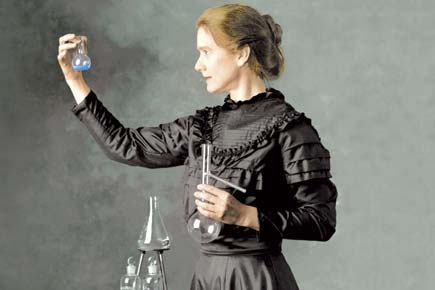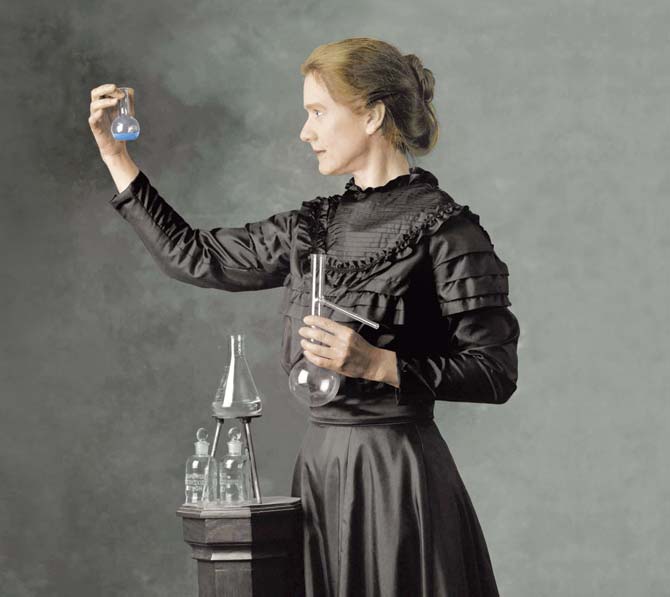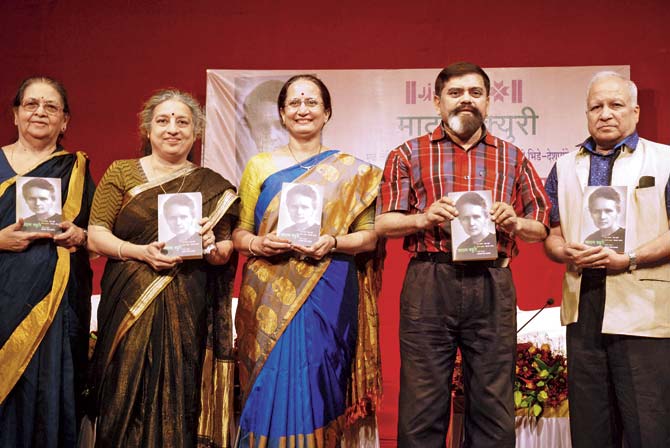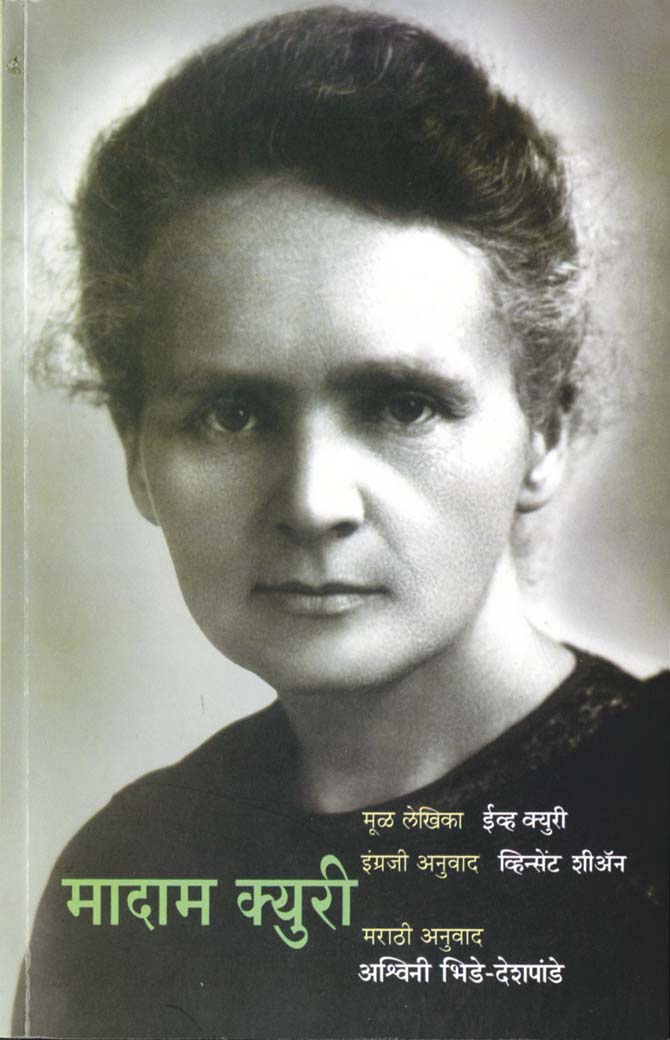Eminent classical singer Dr Ashwini Bhide-Deshpande translates a book on Nobel Prize winner Marie Curie into Marathi, making it accessible to a wider audience and different demographic

Every book finds its truest admirer, writes author Vikram Seth. If that is to be believed, the book Madame Curie, certainly found its truest admirer in eminent classical singer Dr Ashwini Bhide-Deshpande.
ADVERTISEMENT

Marie Curie continued to work feverishly, post her husband Pierre’s death
The biography of the Polish-French Nobel Prize winning scientist, beautifully written by her daughter, Eve, so overwhelmed Bhide-Deshpande, that she translated it into Marathi. The eponymous translation Madame Curie was released a few weeks ago.

Dr Ashwini Bhide-Deshpande (second from l) at the launch of her translation of Marie Curie. Pic/Nandakumar Patil
Dr Bhide-Deshpande fiercely guards her privacy and is usually reluctant to speak about anything to the media but music. So it was with curiousity, awe and much trepidation that this writer went to her Bandra home and found the singer willing to discuss the life and career of the scientist.
Inspirational book
As a new bride when she moved into Sahitya Sahawas, the colony of authors, Dr Bhide-Deshpande felt overwhelmed by some of her neighbours. These were the people whose works she had read and grown up with. One of them, author Deepa Gowarikar, lent her the book Madame Curie to read. Dr Bhide-Deshpande was enthralled by it. Many years later, she came across a copy of this translation by Vincent Sheean on Amazon.com and bought it.
After reading it again, she still felt it overpower her as it had done before. Dr Bhide-Deshpande, who has published a book of her bandeeshes in 2004, and followed it up with part two later, says, “I have the habit of writing for myself. In fact, I have even re-written the Mahabharat for myself. So I thought of translating Eve Curie’s book into Marathi, again, for myself. There is no greater satisfaction than reading in one's mother tongue.
I translated it and gave it to some relatives, neighbours to read. I even gave it as a gift to my brother for his fiftieth birthday. All the people who read it said it was good and I must publish it. That is when I approached Granthali.” After a year long process which included contacting UNICEF that takes royalty from the sales of the book, and her daughter contacting literary agents Curtis Brown in the US, she finally got permission to publish it.
Translation process
Originally, Dr Bhide-Deshpande had intended to finish the first draft during the month she visited her daughter. But it took her 3.5 months. Asked if she allotted a certain time for it every day, like she might for riyaz, she says, “I was obsessed with it. I wrote whenever and wherever I got time. I would translate during the day, at night, while travelling, in hotel rooms, etc.”
Asked if she had studied any book to understand translation, she says, “I had loved the translation of Little Women by Louisa May Alcott, which was done in Marathi as Chaughijani by noted poet Shanta Shelke. I did not study it but somewhere at the back of my mind, I had felt it should be like that.” Generations of school children are taught little more about Pierre and Marie Curie, but that they discovered radium and won the Nobel Prize for it.
But few know more about their lives and other achievements, or that Marie Curie won the Nobel Prize for the second time, or that she was the first woman to receive it; or that the Curies refused to patent the process of purification of radium because that would mean it would only benefit them, and instead, published it so that the world would learn about it, and because it would help in the treatment of cancer.
Big heart
Speaking about the principled nature of Marie Curie, Dr Bhide-Deshpande narrates two anecdotes. She says that after Pierre Curie died, Marie’s father-in-law and brother-in-law told her to keep the first gram of radium that they had purified, as her savings, because she had two daughters to bring up. But Marie donated it to an institution instead.
During an interview, an American journalist asked Marie Curie what she wanted for her lab. Curie replied that she wanted one gram of radium for more experiments, but it was too costly. The American journalist went back home and managed to raise money by asking fellow citizens. It was decided that the money would be ceremoniously presented to Marie Curie in the US, and she could use it to buy the radium.
But on going to the US, Curie told the concerned people that it shouldn’t be given to her, but to her lab, and so, the presentation certificate should say so. They told her to accept the money at the function scheduled the next week and the changes would be made in the certificate later. Says Dr Bhide-Deshpande, “But Madame refused to listen to this.
She insisted a lawyer be brought that night to change the certificate, saying the money was to be given to the lab. She told them, she would have accepted it as they said, but then it would have become her property. What if she died the next day? She said she couldn't guarantee if her daughters would ensure then if it would be given for the intended purpose!”
Tribute to mom
Bhide-Deshpande goes on to explain, “What appealed to me most about Madame Curie was what Eve said about her. She said she was born when her mother was already a celebrity scientist. But all she thought about her mother was that she was an eager, eternal learner. Eve said Marie’s soul was pure.
Even when Marie Curie was dying and became delirious, she did not call her daughters, but she kept talking about experiments, her lab, her work, etc. She used to say be attached to things, not people. She was so attached to her things, her experiments, and her lab. It touched me.” She adds, “The book has soul. It is not merely facts.”
She says further, “Pierre Curie died when Eve, their younger daughter was 1.5-years-old. So Marie Curie brought up their two daughters herself. She felt she could not give them as much time as she wanted to. She worked, performed scientific research and looked after them. But Eve harbours no hard feelings towards her.
She is also not judgmental about her in the book. She has not put her mother on a pedestal. Nor is there any complaint about her.” Dr Bhide-Deshpande’s father is a research scientist and she also has a background in Science. She has a degree in Biochemistry. So did that help during the translation? She said it did to an extent, but Eve being a journalist and pianist herself, hasn’t focused much on Science.
Of Nobel Prizes
She smiles and says, “May be the fact that Eve was a pianist, had a background in music, also appealed to me.” She adds that Eve would jest that she was the only non-Nobel Prize winning member of her family. Her sister Irene Joliot-Curie and brother-in-law Frederic Joliot-Curie also went on to win the Nobel Prize for their discovery of artificial radioactivity.
Her sister became the second woman to win it after Marie Curie. “Interestingly, Eve’s husband Henry Richardson Labouisse Jr later won the Nobel Peace Prize on behalf of UNICEF!,” laughs Dr Bhide-Deshpande. The Jaipur Atrauli Gharana singer is also all praise for Pierre Curie’s language, expressed in his letters when he was wooing his wife before their marriage.
She reads aloud a passage from the English translation of Eve's original French book to illustrate this and also her translation of it. The language truly overpowers. She says, “Pierre was a writer! Translating his writings was the most difficult part of this book. His language flows effortlessly and gently from the heart.”
Another challenge was translating the long sentences in the old English style of the original translator. She ended up breaking many of those sentences into two or three and using “many semi colons and commas.” She also kept the translation both literal and sense-for-sense. In a strange way, there seem to be some similarities between the Curies and Dr Bhide-Deshpande’s family.
 The cover of the book Madame Curie translated by Dr Ashwini Bhide-Deshpande
The cover of the book Madame Curie translated by Dr Ashwini Bhide-Deshpande
Both have links to science, music and now, the letters. Could this be a coincidence? Or is it simply, without giving it much thought, admiration that led to the creation of another book? Coincidence or not, Dr Bhide-Deshpande’s book has given a chance to lakhs of people to read it in Marathi. To have an insight into the renowned scientist's career and life. Her tribute to a daughter’s tribute to her mother.
 Subscribe today by clicking the link and stay updated with the latest news!" Click here!
Subscribe today by clicking the link and stay updated with the latest news!" Click here!






